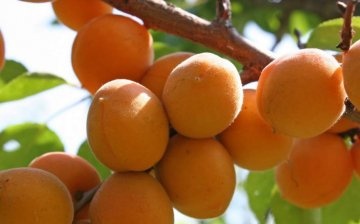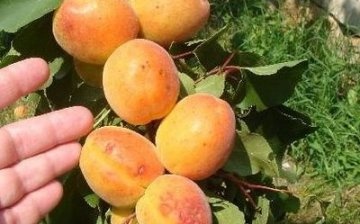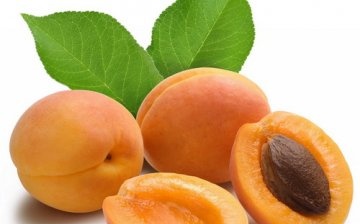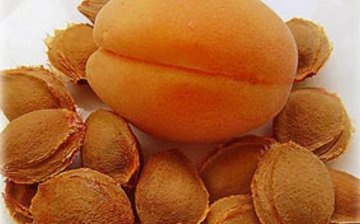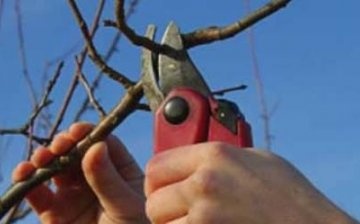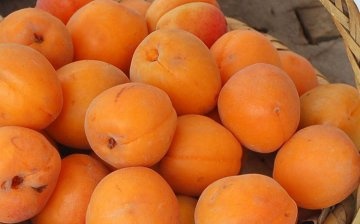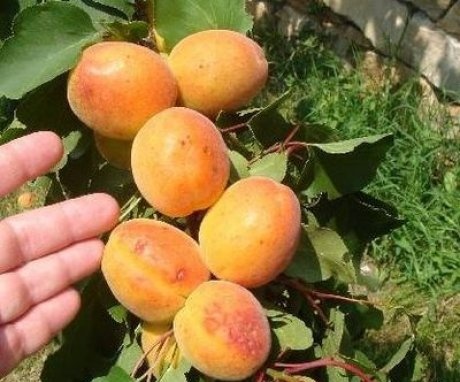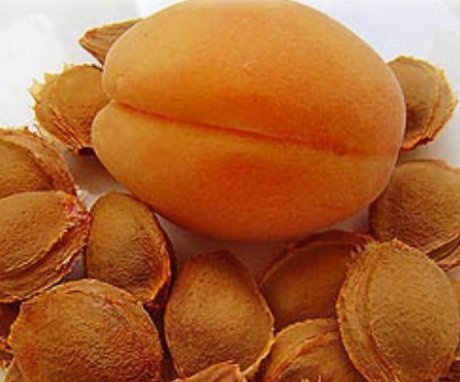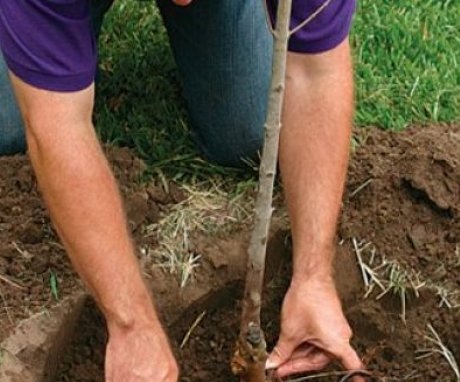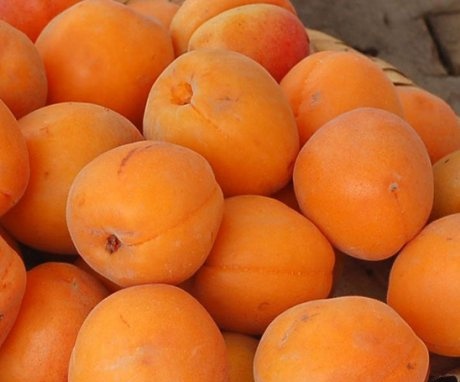Northern triumph apricot: features of the variety, rules of cultivation and care
Apricot variety Triumph Severnyi obtained by crossing the southern Krasnoshchekina tree and the Transbaikal Severny early. For the first time, A.N. Venyaminov, then he lived in the Central Black Earth Zone.
Content
- Features of the Triumph North variety
- Other northern varieties of apricot
- Where to find the North Triumph variety
- Propagation of apricots by seeds
- Planting an apricot
- Tree care
- Harvesting
Features of the Triumph North variety
There is a myth among the people that the apricot is an exclusively southern plant. But gardeners have proven that apricot can grow, bloom and bear fruit even in the northern regions. Apricots give a high yield in the middle lane.
Breeders have worked hard for several generations to grow frost-resistant species:
- The branches of some varieties can withstand temperatures up to -40 degrees, but they are difficult to tolerate sudden changes in temperature.
- The fruits ripened on northern apricots are small and slightly sour. In some ways they are inferior to sweet, ripe southern varieties, but are great for jam, compote or jelly.
- The height of the northern tree can reach 4 meters, the crown is lush.
- The root system does not penetrate deeper than 40 cm.
- The fruits of northern apricots resemble cherry plums.
This is a fast-growing crop, has periods of fruitful seasons and lean ones, up to 20 kg of fruit can be harvested from a 10-year-old tree, the tree lives up to a maximum of 25 years.
Triumph Severnyi is prized not only for its fruits, but also for its beautiful early flowering.
Although bred artificially, the fruits of some northern trees can reach a weight of 50 grams, although on average it ranges from 20 to 35 grams. The fruits are slightly elongated, yellow in color with a pink-red blush, the pulp is easily separated from the stone.
Seeds of the Northern Triumph can be eaten. Their taste resemble a good almond.
Compared to cherry plum, the Northern Triumph has less resistance to diseases, the most dangerous:
- Moniliosis
- Cytosporosis
- Verticillosis
- Clasterosporium disease
Other northern varieties of apricot
There are many other northern apricot varieties. Despite their different appearance, they have one thing in common - the ability to survive and give a full harvest in the northern and central regions of Russia.
The breeder L.A. Kramarenko bred the Iceberg, Alyosha and Lel varieties.
- The iceberg grows up to 3 m, the fruits can be both oval and round, the weight of the apricot is 30 g, the pulp is very tender and juicy, sweet, without a sour taste.
- Alyosha - the maximum tree height is 4 m, the crown is thick and wide. Fruits are small, oval in shape, weighing up to 20 g, yellow with a soft blush. The pulp is tender, slightly sour.
- Lel is smaller, grows up to 3 m, the crown is rare. Fruits are elongated, juicy, sour to taste. It gives high yields in the central regions of the country. Success ripens late, tolerates severe frosts and gives a good harvest. Medium-sized fruits with dotted blush. The pulp is yellow, juicy, sweet and sour. The kernel is bitter, so you can't eat it.The best conditions in the Central and Central Black Earth regions.
- Michurinets is a self-fertile variety. The fruits grow large, up to 40 g, oval, bright orange in color, juicy flesh with a characteristic sourness. Ideal conditions for this apricot in the Central and Central Black Earth regions.
- The Kichishinsky variety was first obtained at the South Ural Research Institute. The tree ripens late, but gives a high yield. The fruits are small, round, gaining weight no more than 15 g. The pulp is tender and juicy, like other northern varieties, sweet and sour. Best suited for the West Siberian, Volgo-Vyatka and Ural regions.
Northern Triumph is distinguished by early flowering.
It tolerates winter well and gives a high yield, fruits reach 50 g in weight, oval asymmetric shape, with a reddish blush. The pulp is orange, juicy and sweet. You can even eat a bone. It gets along well in the Central region, is the best among all northern varieties.
Where to find the North Triumph variety
It is not so easy to buy planting material of the Triumph Severny variety, you cannot find it on the market, but cultivating it yourself will take a lot of time. Therefore, it is recommended to contact specialized nurseries, which themselves grow seedlings and have a good rating and reputation.
If the grafting is with an open root system, then during transportation it is important to ensure that the roots do not dry out or become weathered.
It is worth planting a tree in early spring.
If the root system is closed, then the planting period is not so strictly limited. Before picking up the graft, you need to make sure that the tree was grown in the exact container in which it is currently located, and was not transplanted before selling.
If the gardener knows how to vaccinate on his own, then the problem of finding high-quality seedlings automatically disappears. It turns out that at home you can get any of the known types of apricots. The vaccination is recommended in late March - early April, when the risk of frost is eliminated.
Propagation of apricots by seeds
Where to find the first seedling becomes more or less clear, but if you want to grow a whole apricot orchard, especially in the Central and Northern regions, then things will be a little different. In principle, you can immediately purchase a large batch of seedlings, but it is much more pleasant and economical to grow apricots for the garden yourself.
Reproduction carried out by seeds or vaccination.
If you grow a tree from seeds, then it will be more resilient, it is easier to tolerate temperature changes and illness. Variety properties are inherited in most cases.
And getting the bones is a very simple matter:
- The seeds need to be washed well and, without waiting for them to dry, should be planted in the ground in summer, or placed in wet sand and planted in mid-to-late September.
- If the seeds were planted in the summer, then you will need to constantly monitor the level of soil moisture.
- If the weather is hot and sunny, then bones will need regular watering.
- You can plant seeds in the spring. To do this, you need to take seeds that were set aside in the summer and soak in cold water for 5 days.
- The water should be fresh and renewed periodically.
- Then the seeds are placed in a bag with wet sand, moss or sawdust.
- Several holes need to be made in the bag for air to pass through.
- You can transplant a bone into the ground immediately after it cracked and sprouted.
- Depending on the variety, this period will last from 50 to 100 days.
- If the seed germinated too early, then it must be transferred to a room where the air temperature does not exceed 2 degrees Celsius.
- The optimal time for transplanting future apricots into the soil is May.
- Mineral and organic fertilizers must be added to the soil in advance.
- Seeds are laid out to a depth of 7 m, the bed must be mulched with humus, peat or sawdust.
- Over the summer, an apricot can grow a whole meter, and after a year it can be moved to a permanent location or used for vaccinations.
- The tree will give its first harvest in 4 years.
Planting an apricot
The apricot belongs to the Rosaceae family. Even if it grows far from the southern regions, it is still worth taking care of the sunniest, brightest and highest place in the garden.
You need to plant the plant before the buds wake up, that is, around the end of April:
- The distance between trees should not be less than 5 meters.
- The pit in which the apricot will be placed has been prepared since autumn, its size is 70 * 70 * 70 cm.
- Do not forget that root system in diameter more than the crown at least twice.
- The soil should be well loosened, drainage (gravel or crushed stone) is laid out on the bottom of the pit. After that, you can add a soil mixture, which consists of a layer of earth, humus and mineral fertilizers. Wood ash, lime and ammonium nitrate are used as an additive. You should be careful not to burn the roots with lime. Sprinkle this whole mixture with earth so that it does not come into contact with the roots.
- If the garden plot is located above groundwater, then a small hill is made.
- After the tree is planted, a watering circle is made, this will require 2 buckets of water.
- Water should not fall on the mound, thereby exposing the root system.
If the deadline for planting an apricot has approached, and the temperature has not yet stabilized, then the seedling is formed in the form of a slate.
This means that the apricot is planted at an angle of 40 degrees to the surface of the ground, thereby receiving heat from it. The crown should face south.
To prevent the tree from changing its horizontal position, the apricot branches are pinned to the soil with any hooks. In early spring, the extra branches are cut "into a ring".
Trees that develop horizontally receive 300 degrees more heat than those that are 2 meters high.
Tree care
Since Triumph North is suitable for growing in cool regions, it is very important to immediately reject weak individuals.
This is done already in the first year:
- For the winter, plants are left without any shelter, especially without polyethylene and roofing material, which do not allow cold air to pass through.
- The first and all subsequent pruning is done in early spring.
- Unhealthy or frozen branches are pruned, long shoots are shortened, and the extra ones are completely cut out.
- The cut must be treated with hellish varnish or special paint mixed with natural drying oil.
Skeletal branches and trunks are whitewashed in late autumn or early spring, the whitewash is mixed with copper sulfate.
If there is a wound or frostbite on the tree, then at the end of spring they are covered with Kuzbaslak or garden pitch. To prevent the tree from drying out and developing well, you need to ensure regular abundant watering.
Top dressing is carried out during the flowering period until harvest.
If a young tree has given too many fruits, and the branches are not yet strong enough, then the ovaries are thinned out after the previous ones have fallen off. If it is not clear how many ovaries need to be removed, then you need to focus on the following ratio: 1 fruit per 20 leaves.
To protect the apricot from aphids in advance, nasturtium is planted around the tree.
If the crown is too thick, then it can be periodically thinned out for better light penetration, especially in the central and northern regions. Anti-aging pruning is done after harvest. The older the tree, the less it likes pruning.
Harvesting
For consumption or drying, apricots of any variety are harvested after they are fully ripe.
But for transportation, you need to choose a special period when the fruits:
- Have already grown to the maximum value.
- They have acquired the color characteristic of the variety, but the flesh is still firm.
It is called technical maturity of the fruit... Consumer maturity is determined by the taste of the pulp, juiciness and specific aroma.
If the harvest is harvested for export, then the eating takes place 2-3 days before consumer maturity. If for personal purposes, then you can harvest the fruits as they ripen.
It is important to keep an eye on the weather during harvest.
That is, to collect fruits in sunny weather and after the dew has evaporated. It has been proven that if the harvest was carried out in cold weather or after dew, then they will be poorly stored, and the quality may deteriorate. Fruits cannot be harvested even in hot weather, at this time the respiration process is activated and apricots may not withstand long-term storage. The optimal time is 10-11 am or 5-19 pm.
More information can be found in the video.



